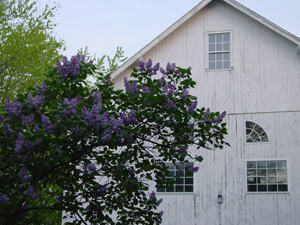
CHAMBERSBURG, Pa. (AP) – A busload of aficionados from as far away as Ohio and New Jersey rode around Franklin County on a recent Saturday to admire barns.
Forty-seven people made the bus tour presented by the Historic Barn and Farm Foundation of Pennsylvania. Others were turned away for lack of seating.
Charles Leik, president of the National Barn Alliance, was among those listening to the explanation of the architectural details on the stone Sweitzer barn on Kriner Road. He had just returned from helping to start a barn preservation group in Sacramento, Calif.
“Barns are the most impressive structures on our farms and grazed lands,” Leik said. “Southeast Pennsylvania is the mother lode of barns in the United States, extending into Maryland and the Shenandoah Valley in Virginia.”
Leik said he admires brownstones and the Taj Mahal, but the vernacular architecture of the American barn is close to his heart. He grew up on a farm in Michigan.
“Barns reflect the people of the immediate region,” he said.
The 1813 barn on Kriner Road was rescued recently from demolition by the Guilford Township Supervisors, whose deal with a warehouse developer set aside the farmstead for preservation. A row of young evergreens is beginning to shield the farmstead from the warehouse.
“Our hope is to have the Franklin County Tourism Bureau out here and use it as their base of operations,” Supervisor Greg Cook said.
The township plans to have students from the Franklin County Vocational Technical School renovate the interior of the house, then eventually tackle the barn restoration.
“The most logical use (for the barn) would be a farm implement museum,” Cook said.
Cook was excited that the barn historians found what could be the signature of the barn builder on a mortar joint.
“I’m sure one of them will be back to study it,” he said.
The builders used wood ash to darken the mortar of the joints to accentuate the cut of the stone, according to Douglass Reed of Preservation Associates Inc., Hagerstown, Md.
“This is beautiful Scots-Irish work,” he said. “We had a lot of cutters because of the work on the C&O Canal.”
The barn put its best face toward the road:
The quoins (corner blocks) are smooth.
Joists, probably 42 feet long, were trimmed on all four sides.
Decorative keystones are part of the stone work above each door.
Bob Ensminger, octogenarian author of the bible on Pennsylvania barn architecture, explained that limestone was readily available and easy to work.
Former state Rep. Shelia Miller of Womelsdorf carried the loudspeaker for the tour. She founded the Pennsylvania barn foundation three years ago to emphasize the plight of the state’s barns.
A 2006 study “proved that Pennsylvania had a treasure trove of old barns worthy of saving,” she said, but Congress has failed to appropriate money for any preservation efforts.
Others states are stealing Pennsylvania’s agricultural heritage, she said. Barns are being dismantled and reassembled out of state.
Bigger barns are at the greatest risk of because it costs more to maintain them, Leik said.
Most have outlived their usefulness on the modern farm and must be converted for other uses – such as a storage shed or a party barn, Leik said. Farmers recall the drudgery of using them before the days of automation.
“They’re going to be somewhat of a monument,” Leik said.
Gene Wingert, a St. Thomas, Pa., hog farmer, said he keeps cattle in his 1840 Sweitzer barn. He estimated that over the years he has invested $100,000 to maintain the structure. His barn was one of nine on the foundation’s third annual barn tour.
Wingert, a board member of the foundation, has lobbied since its inception for a tour of Franklin County barns.
The tour is a new twist for local ag tourism, which has focused largely on introducing urban and suburban children to fun days on the farm. Many participants in the two-day tour stayed at the Four Points Sheraton.
Agriculture is the leading industry in the state and county. Tourism comes in second in both.
The icon of ag tourism is the antiquated barn.
Barns reached their high watermark in the 1950s, Leik said. Within 40 years just 20 percent will remain.
Local photographer Phil Schaff said from 1999 to 2010 he has taken pictures of 110 brick-end barns across the county, 108 of them with designs.
“We’ve lost 10,” he said.
A barn was often the first structure built on a settler’s new farm, Leik said. It proclaimed a farmer’s success at his occupation.
“The barn makes you a farmer,” Leik said. “I like to call them trophy buildings.”
He’s hoping awareness will win back many of the trophies.
___
Online:
http://bit.ly/jsB0N2
___
Information from: Public Opinion, http://www.publicopiniononline.com
Copyright 2011 Associated Press. All rights reserved. This material may not be published, broadcast, rewritten, or redistributed.
AP-WF-06-23-11 1316GMT
ADDITIONAL IMAGES OF NOTE


